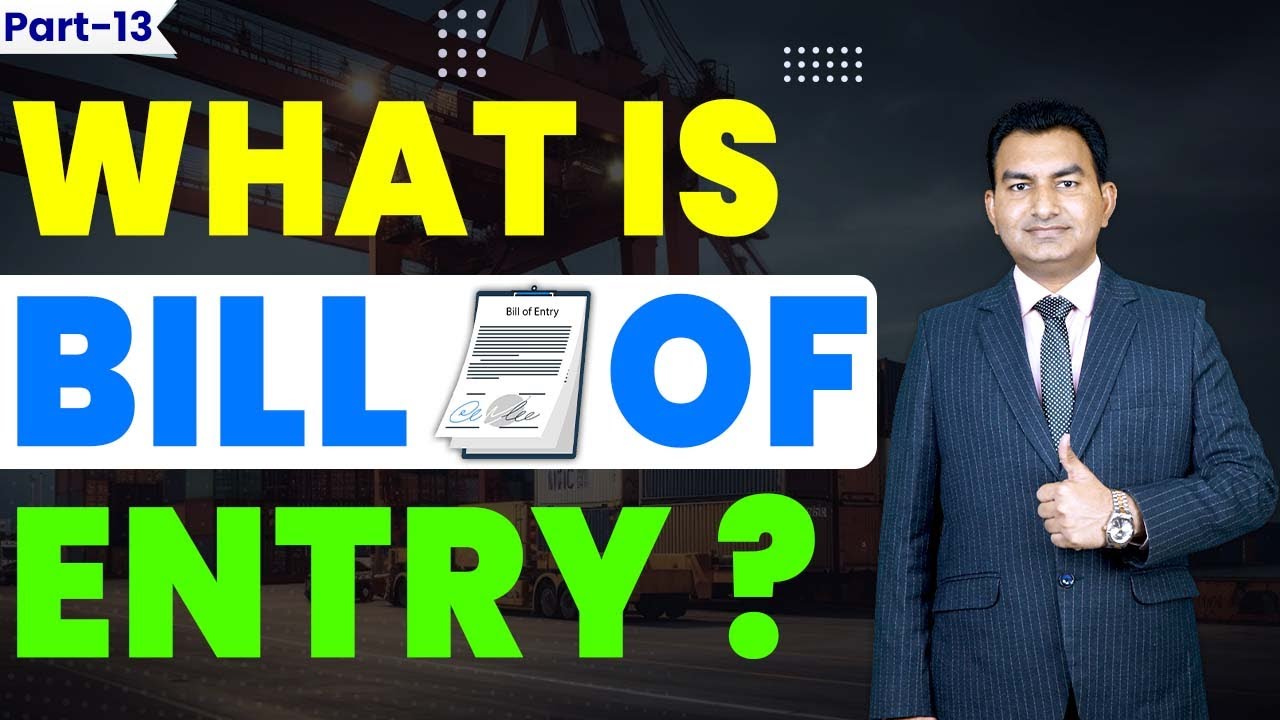What is a GST Bill Of Entry?
- 18 Aug 24
- 16 mins

What is a GST Bill Of Entry?
Key Takeaway
- A Bill of Entry is essential for legally importing goods into India, ensuring compliance with customs and GST regulations.
- The document allows for the accurate assessment of customs duties and GST, which are critical for legal and financial compliance.
- There are three types of Bill of Entry—Home Consumption, Warehousing, and Ex-Bond—each serving different import needs and tax payment schedules.
- Filing a Bill of Entry on the GST Portal facilitates the efficient clearance of goods and ensures that all necessary taxes are properly calculated and paid.
- Proper classification of goods using the Harmonized System of Nomenclature in the Bill of Entry is crucial to ensure correct duty rates and avoid tax discrepancies.
A GST Bill of Entry is a crucial document used in India that must be filed by importers when goods are imported into the country. This document is required for the assessment of customs duties and GST and is mandatory for the legal clearance of goods through customs. It ensures that all imported goods are properly declared in terms of quantity, type, and value, and are assessed for applicable taxes under the GST framework.
Why is Filing a Bill of Entry Important?
Filing a Bill of Entry is important for several reasons:

- Legal Requirement: It is a statutory requirement under the Customs Act and GST regulations. Without filing this document, imported goods cannot be legally cleared through customs in India.
- Tax Assessment: It provides all necessary details required for the assessment of customs duties and GST on imported goods. Accurate payment of these taxes is crucial to avoid legal penalties and interest.
- Compliance and Clearance: Proper filing ensures compliance with Indian customs regulations and facilitates the smooth clearance of goods at the port of entry, avoiding delays that could impact business operations.
- Documentation for Audit and Records: It serves as an essential record for future audits by tax authorities and helps maintain transparency in financial documentation.
Filing a Bill of Entry is thus integral to the import process, ensuring that all legal, tax, and regulatory requirements are met efficiently.
How Many Types of Bill of Entry are There?
There are three primary types of Bill of Entry used in the context of imports in India:
- Home Consumption Bill of Entry: This is filed when the imported goods are to be released directly for use within the domestic market without being placed in a bonded warehouse. It's the most common form used when goods are meant for immediate sale or use.
- Warehousing Bill of Entry: Used when the imported goods are intended to be stored in a customs bonded warehouse. The duties and taxes can be deferred until the goods are actually removed from the warehouse and brought into the domestic market for consumption.
- Ex-Bond Bill of Entry: This type is filed for the clearance of goods from a customs bonded warehouse into the domestic market. The duty is paid only when the goods are actually removed from the warehouse, providing cash flow benefits to the importer.
These types reflect different needs and timing for the payment of customs duties and taxes, offering flexibility to importers based on their specific requirements.
Details to be Furnished in Bill of Entry

When filing a Bill of Entry, several key details must be accurately provided to ensure proper assessment and clearance of the imported goods. These include:
- Importer’s and Exporter’s details: Names, addresses, and other contact information of both the importer and the exporter.
- Country of origin and destination: The origin country of the goods and the destination within India.
- Bill of Lading or Airway Bill Number and Date: Essential for tracking and verifying the shipment.
- Invoice details: Complete invoice information including value, currency, and terms of sale.
- Packing list: Details about how the goods are packed, including weights and dimensions, which are crucial for assessing volume and handling requirements.
- HSN code: The Harmonized System of Nomenclature code which helps in determining the rate of duty applicable to each item.
- Description of goods: Detailed descriptions of the goods being imported, including quantities and specifications.
- CIF value: The cost, insurance, and freight value of the goods, which is used to calculate duties.
- Type of duty and rate applicable: Details of various duties applicable, like basic customs duty, integrated GST, and any other cess or duty imposed on the goods.
Accurately furnishing these details in the Bill of Entry is critical for the correct assessment of taxes and duties and for ensuring compliance with customs regulations.
Classification of Goods
The classification of goods within a Bill of Entry is a fundamental step in the customs clearance process, impacting everything from duty calculations to compliance with international trade regulations. Here’s a detailed look at how goods are classified for customs purposes:
- Harmonized System of Nomenclature (HSN): The primary tool for classifying goods in a Bill of Entry is the Harmonized System of Nomenclature. Developed by the World Customs Organization (WCO), the HSN is a globally recognized standard that assigns a specific six-digit code to various types of goods. These codes help in identifying products during the customs process and are used internationally to standardize the classification of items.
- Determining the Correct HSN Code: Identifying the correct HSN code requires understanding the nature, composition, and function of the product. The HSN code for a product is detailed in the Harmonized System, which provides chapters and sub-chapters grouped by type of goods; for example, agricultural products, machinery, textiles, and so forth.
- Impact on Duty and Taxes: The classification of goods directly affects the customs duties and taxes levied on an import. Different products have different duty rates, which are determined based on their HSN classification. Accurate classification is crucial to ensure that the correct duty rates are applied, avoiding overpayment or underpayment of taxes.
- Compliance and Documentation: Proper classification is essential for compliance with both national and international trade laws. Misclassification can lead to penalties, fines, or delays in the clearance of goods. Importers must provide detailed descriptions and technical specifications of their products to assist customs authorities in verifying the classification.
- Updates and Changes: The HSN codes are periodically reviewed and updated to reflect changes in technology, market practices, and environmental considerations. Importers need to stay informed about these updates to ensure ongoing compliance and accurate duty assessment.
Steps for Filing of Bills of Entry
Filing a Bill of Entry is an essential process for the clearance of imported goods through customs in India. It involves several steps that ensure the goods are legally imported, properly declared, and correctly taxed under the prevailing customs and GST regulations. Here's a step-by-step guide to filing a Bill of Entry:
Step 1: Preparation of Documents: Before filing the Bill of Entry, ensure all required documents are prepared and readily available. These include the commercial invoice, packing list, Bill of Lading or Airway Bill, insurance documents, and any certificates required (like the Certificate of Origin). Additionally, ensure that you have the correct HSN codes and descriptions for all goods.
Step 2: Submission via ICEGATE: The Bill of Entry must be filed electronically through the Indian Customs Electronic Gateway (ICEGATE). Importers or their customs brokers must register on the ICEGATE portal to access the services. Here, the Bill of Entry can be filed online, with all the necessary details entered accurately to match the physical shipment.
Step 3: Assessment: Once the Bill of Entry is filed, customs officers assess it to determine the correctness of the information provided and to calculate the duties and taxes due. This assessment might involve a physical inspection of the goods or a documentary check to verify the compliance of the goods with Indian standards and regulations.
Step 4: Duty Payment: After assessment, the duties and taxes calculated must be paid. This payment is usually done through the ICEGATE portal, where the total amount payable will be displayed. Prompt payment ensures there are no delays in the release of the goods from customs.
Step 5: Customs Examination: Post-payment, a customs officer will conduct a physical examination of the goods to ensure that the details provided in the Bill of Entry correspond with the actual products imported. This step is crucial to verify quantities, marks, numbers, and the condition of the goods.
Step 6: Grant of Entry Inwards: Once the goods are examined and all formalities are completed, customs officials will grant the Entry Inwards, which is the permission for the vessel to unload the goods. This formal approval is necessary before the goods can actually be moved out of the port or airport.
Step 7: Release of Goods: The final step is the release of the goods by customs after ensuring that all regulatory and fiscal requirements have been fully complied with. The importer can then take delivery of the goods for further distribution or sale.
Tips for Efficient Filing
- Ensure accuracy in all documents to prevent delays.
- Stay updated on changes in customs regulations and tariff rates.
- Consider hiring a professional customs broker if the import process seems complex.
Bill of Entry Under GST
A Bill of Entry is a legal document that must be filed by importers at the time of importing goods into India. It is submitted to the customs authorities and serves multiple purposes:
| Purpose of Bill of Entry | Description |
|---|---|
| Legal Declaration | Acts as a declaration by the importer regarding the details of the goods being imported, including type, value, and quantity. Essential for customs clearance. |
| Assessment of Duties and Taxes | Facilitates the assessment of customs duties and the calculation of Integrated Goods and Services Tax (IGST) and any applicable cesses, replacing CVD and SAD under the GST framework. |
| Input Tax Credit | Allows businesses to claim Input Tax Credit (ITC) on IGST paid during the import process, provided the goods are used in business operations. Critical for tax compliance and accounting. |
| Documentation for Compliance | Serves as a record detailing compliance with import regulations. Used by GST authorities for audit and verification to ensure correct tax payment and ITC claims. |
Additional Responsibilities Under GST
With the implementation of GST, importers must be particularly diligent in ensuring that the Bill of Entry is accurately filled out. The details such as the GSTIN of the importer, the correct valuation of goods, the applicable HSN codes, and the corresponding IGST rates need to be meticulously recorded. Errors or discrepancies in the Bill of Entry can lead to delays in clearance, potential penalties, or issues with claiming ITC.
How to Make a Bill of Entry Payment?
Making a Bill of Entry payment involves several steps that ensure the customs duties and taxes on imported goods are properly settled. Here’s how to make a Bill of Entry payment in India:

Step 1: Calculate Duties and Taxes : Once the Bill of Entry is filed and assessed by customs officials, the exact amount of duties and taxes applicable is determined. This calculation is based on the classification of goods, valuation, and the applicable rates of customs duty, GST, and any other cesses.
Step 2: Online Payment through ICEGATE: Payments for the Bill of Entry can be made online using the Indian Customs Electronic Gateway (ICEGATE). Importers need to:
- Log in to the ICEGATE portal using their credentials.
- Navigate to the e-payment section.
- Select the challan or Bill of Entry for which payment is due.
Step 3: Select Payment Mode: Importers can choose from various payment modes available on ICEGATE, including net banking, debit card, or credit card. Most major banks are integrated with ICEGATE to facilitate these payments.
Step 4: Make the Payment:
- Complete the payment process through the selected payment method.
- Ensure that the transaction is successful and keep a record of the transaction details for future reference.
Step 5: Confirmation and Receipt: Once the payment is made, ICEGATE will generate a receipt or a challan of payment, which serves as proof of payment. This document is important for further customs clearance processes.
Step 6: Customs Clearance: After payment, the customs authorities verify the payment details against the Bill of Entry. Once confirmed, they proceed with the customs clearance, leading to the release of goods.
Tips for Smooth Payment Process
- Ensure that all data entered on ICEGATE matches the details on the Bill of Entry to avoid discrepancies.
- Make payments well within the deadlines to avoid any delays in the release of goods.
- Keep all receipts and transaction details securely for any future audits or verifications.
💡If you want to pay your GST with Credit Card, then download Pice Business Payment App. Pice is the one stop app for all paying all your business expenses.
What is difference between bill of lading and bill of entry?
The Bill of Lading and Bill of Entry are both crucial documents in international trade, but they serve distinct roles and are used at different stages of the shipping and customs clearance process. Understanding the differences between these two documents is essential for anyone involved in importing or exporting goods. Here's a breakdown of their key differences:
| Feature | Bill of Lading | Bill of Entry |
|---|---|---|
| Purpose | Serves as a receipt for goods shipped, a contract of carriage, and a document of title. | Used for declaring goods at customs for duty assessment and clearance. |
| Issued By | Issued by the carrier or their agent. | Filed by the importer or their customs broker. |
| Function | Details type, quantity, and destination of goods; ensures delivery to the correct party. | Clears goods through customs, ensures payment of duties and taxes. |
| Legal Aspect | Legally binding document that evidences the condition of goods and terms of transport. | Mandatory for legal importation, focusing on tax and duty compliance. |
| Scope and Use | Used throughout the shipping process from loading to delivery. | Used solely for customs clearance within the importing country. |
| Legal Obligations | Concerns the transport and condition of goods. | Focused on compliance with customs duties and taxes. |
| Issuance Timing | Issued when goods are loaded onto the shipping vessel. | Filed after goods arrive in the destination country and before customs clearance. |
This table distinguishes between the roles and responsibilities associated with the Bill of Lading and the Bill of Entry, highlighting how each document supports different stages of the import and export process.
Advantages of the Bill of Entry
The Bill of Entry is a crucial document in the import process, offering several advantages that facilitate trade and regulatory compliance. Here are some key benefits associated with the Bill of Entry:
1. Customs Clearance
- Efficient Processing: The Bill of Entry enables efficient customs clearance of imported goods. By providing detailed information about the goods, it helps customs authorities quickly process and release shipments.
2. Tax and Duty Assessment
- Accurate Duty Calculation: It allows for the accurate calculation of duties and taxes based on the declared value, type, and quantity of goods. This helps ensure that the government receives the correct amount of revenue and that businesses know their financial liabilities upfront.
3. Legal Compliance
- Regulatory Adherence: Filing a Bill of Entry ensures compliance with local customs regulations and international trade laws. This adherence is crucial for avoiding legal penalties and facilitating smooth international trade.
4. Record Keeping
- Audit Trail: The document serves as an official record of the goods that have been imported. This is important for auditing purposes, where businesses and customs authorities may need to verify past transactions.
5. Transparency
- Clear Documentation: The Bill of Entry provides a transparent account of all transactions involved in the import process. This transparency is beneficial for both governmental oversight and for businesses maintaining clear records for internal and external audits.
6. Input Tax Credit (ITC)
- GST Compliance: Under the GST regime, the Bill of Entry is used to claim Input Tax Credit on the goods imported. This is crucial for businesses as it reduces the cost of the goods by providing a tax credit against the GST payable on imported goods.
7. Facilitation of Trade
- Streamlined Operations: By standardizing the documentation required for imports, the Bill of Entry helps in streamlining operations at ports and reducing delays. This efficiency is critical for businesses that rely on timely supply chain operations.
8. Protection Against Fraud
- Security Measures: The detailed information required in the Bill of Entry helps protect against fraud by ensuring that all goods are properly documented and taxes calculated based on correct valuations.
The Bill of Entry is not just a bureaucratic requirement but a tool that supports the economic and operational aspects of importing goods into a country. Its proper use ensures that trade is both efficient and compliant with all necessary regulations, aiding businesses in managing their international trade obligations effectively.




















